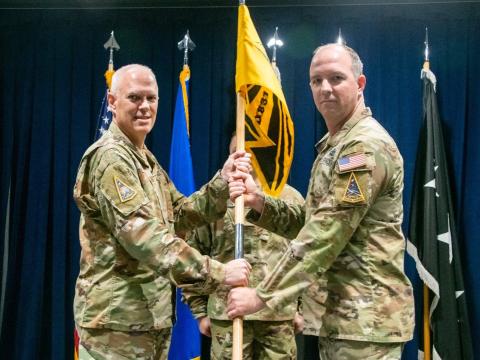International Relationships Are Key to Accelerating Technology
To succeed against near-peer adversaries, the U.S. Department of Defense’s Research and Engineering arm is partnering more and more with allies and partners to rapidly bring in key technologies.
The department is pinpointing countries that can offer emerging technologies or other products that can close U.S. capability gaps, and then is working through the partnerships to quickly bring the prototypes and solutions into the U.S. military, explained Undersecretary of Defense for Research and Engineering (USD R&E) Heidi Shyu, speaking March 11 at AFCEA International’s inaugural TechNet Emergence conference held in Reston, Virginia, March 11-12.
Technologies that aid in air and missile defense are of particular focus, Shyu said.
“I have never engaged so much with allies and partners before,” the undersecretary exclaimed. “We have numerous bilateral and tri-lateral agreements. Last year alone, I visited seven countries, [including Italy, South Korea, Norway and Australia].”
The USD R&E has 98 ongoing projects with 26 countries, where the United States is leveraging partner technologies that those countries have matured.
For example, Norway, in collaboration with the U.S. Naval Air Warfare Center Weapons Division at China Lake, California, is developing a low-cost advanced solid fuel ramjet engine that can travel at the speed of MACH 4. The program, called the Tactical High-speed Offensive Ramjet for Extended Range, or THOR-ER, involves the Norwegian Defence Research Establishment and Norwegian industry partner Nammo Group.
“In Norway I visited the Nammo plant where they are designing ramjet engines in collaboration with China Lake,” Shyu said. “That could triple the range of the 155 [milimeter advanced gun system]. Ukraine could use that today.”
Later this year, Shyu is visiting Finland, Belgium, the Netherlands and the United Kingdom. With Canada and Australia, the United States is collaborating on over the horizon radar capabilities. “One of the things I did was I created a special access program so we can share the most sensitive information with each other,” she noted. With Japan, which is developing a missile propulsion system, USD R&E is coordinating the collaboration with one of the United States’ new missile programs.
In addition, Shyu is accelerating technologies from industry to support joint operations.
“It is very clear that every service is focused on capability gaps that the service needs,” she noted. “But we don't fight within a single service only, so, we are focusing on capability gaps for the joint mission. We are working very closely with the Joint Staff and all the COCOMS [U.S. combatant commands] and all the services. We then figured out, what are the joint warfighting capabilities we need in a highly contested fight. ... But joint development means joint production.”
I have never engaged so much with allies and partners before. And we have numerous bilateral and tri-lateral agreements.
The office stood up the Rapid Defense Experimentation Reserve, or RDER, last year to bring in such technologies based on warfighting scenarios “of significant interest” to the department, to find solutions for joint fires, contested logistics, multidomain command and control, and other areas. “Based on the specific scenarios, we started looking for prototypes that we could accelerate and pull through,” she noted.
They have funded a first Tranche, with Congress’ budget inactivity impacting the funding of other tranches. The office has conducted a technology readiness experimentation, or T-REX, with the National Guard examining 30 different pieces of equipment. The warfighters provided feedback and the office ensured it mature enough as far as technical readiness to be employed in a major military exercise such as Northern Edge or Valiant Shield.
“Once it has demonstrating military utility, it is important to get it into procurement and get it into production as quickly as possible,” Shyu emphasized.
Meanwhile, under the Accelerating Procurement and Fielding of Innovative Technologies, or ACFIT, program, Shyu is directing accelerating key technologies with direct funding to 25 companies of $10 million to $20 million in support of initial low rate production of capabilities. “This has helped [avoid] the valley of death,” she said.
Amongst a broad range of capabilities, the ACFIT effort has funded unmanned surface vehicles with modular payloads that could carry missiles or whatever is needed. The vehicles have a vertical take off and landing capability and could be deployed from land or ships. In addition, the effort funded sensors for unmanned vehicles that detect mines. For the Army Special Forces, the program has quickly supplied advanced night vision goggles with double the field of view, a high resolution and a lighter weight. “The Army Special Ops folks said, ‘I don't want to wait two years, I need it now,’” Shyu noted. “So we provided the funding for the small company to go into production and those are delivering today.”
“All of those things you could think of that in a highly contested fight is highly relevant, that's what we'll be focusing on, with rapid prototyping and experimentation, exercises, and pulling it quickly into production for the join fight,” she emphasized.
@DeptofDefense is working with industry, including small businesses to rapidly move prototypes and solutions for near-peer competition. I’ve never engaged so much with allies & partners. We have 98 projects with 26 countries days Dr Heidi Shyu #AFCEATechNet @ AFCEA pic.twitter.com/5PwU7m0IOl
— Kimberly Underwood (@Kunderwood_SGNL) March 11, 2024




Comments